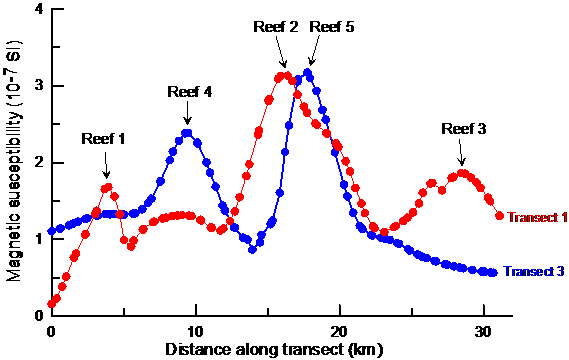58th Annual Report on Research 2013 Under Sponsorship of the ACS Petroleum Research Fund
Reports: ND851942-ND8: A Study of the Relationship Between Hydrocarbon Migration and Magnetic Alteration of the Michigan Basin Soils and Sediments: Towards Understanding the Magnetic Signature of Hydrocarbons
Aleksey Smirnov, PhD, Michigan Technological University
Oil and gas reservoirs are often associated with significant magnetic anomalies arguably caused by diagenetic alteration of magnetic and other iron-bearing minerals in hydrocarbon seepage environments. However, our knowledge of the mechanisms and pathways of hydrocarbon-induced magnetic alteration remains incomplete hampering the development of reliable exploration or environmental monitoring methods. This project seeks to improve the fundamental understanding of the magnetic signature of hydrocarbons by a rigorous experimental investigation of the genetic relationship between the hydrocarbon migration and magnetic properties of sediments overlaying the oil-bearing formations of the Silurian northern pinnacle reef belt of the Michigan Basin.
Total of 248 near-surface sediment samples were collected from approximately one meter depth during two field seasons in 2012 and 2013. Physical properties (e.g., density, texture) were determined for all samples and their color was classified according to the Munsell color system. Granulometry and petrological analyses of the sediments have been conducted using petrological and optical microscopy, and microphotography. In addition, the majority of the collected samples were subjected to magnetic analyses in order to determine the type, concentration, and grain-size distribution of magnetic minerals, the relative amount of superparamagnetic minerals, and the relative amount of diamagnetic, paramagnetic, and ferromagnetic minerals present in the samples. These analyses have been conducted on both bulk samples and their grain size fractions (425 μm, 250 μm, 125 μm, 63 μm, 45 μm, <45 μm), and in some cases on magnetic extracts. The magnetic analyses include:
1. Measurement of mass-specific magnetic susceptibility;
2. Measurement of frequency-dependent susceptibility at frequencies of 976 Hz, 3904 Hz, and 15616 Hz;
3. Measurement of magnetic field-dependent susceptibility (in fields ranging from 2 to 700A/m over 20 steps);
4. Measurement of temperature dependence of low-field magnetic susceptibility within a –196 °C to 700 °C range (the measurements were done in inert argon atmosphere to minimize alteration of samples);
5. Measurement of the following magnetic hysteresis parameters: saturation magnetization (Ms) before and after the high-field correction, saturation isothermal remanent magnetization (Mrs), coercivity (Hc), and coercivity of magnetic remanence (Hcr);
6. Measurement of first-order reversal curve (FORC) diagrams to estimate the magnetic interactions in the samples.
The obtained experimental data were used to create maps of distribution of magnetic susceptibility and other magnetic parameters to evaluate the dependence of magnetic alteration on rock type, lithology, geochemistry, and the distance from a hydrocarbon reservoir.
The initial sampling in 2012 was carried out over a 4 sq. km area southeast of Bear Lake (MI) to allow the direct comparison with geochemical data previously obtained from the same area. Although the processing and analyses of these initial data have not been finished yet, the preliminary results from do not show a clear correlation between the distribution of C1-C6 hydrocarbons, underlying reef structures, and magnetic susceptibility values (with the possible exception of tentative negative correlations between susceptibility and propane data) within the Bear Lake area. This lack of correlation was interpreted as a result of the limited extent of sampling area focusing upon hydrocarbon-producing well locations.
Accordingly, sampling area in 2013 was expanded covering about 150 sq. km in the northwestern corner of Michigan's Lower Peninsula. Most samples were collected along five ~40 km long transects across the trend of the Niagaran Reef System and represented areas both over and away from known hydrocarbon sources.
The preliminary data on low-field magnetic susceptibility from this larger area indicate a well-defined correlation between the location of the hydrocarbon-producing Niagaran Reef System and high susceptibility values (Figure 1). We note that the sampling area is dominated by sandy soils, described as glacial drift with deposits in excess of 300 m in thickness. The almost perfect correlation observed in our data suggests that magnetic anomalies associated with hydrocarbon seepage within these soils are essentially vertical and not subject to the diffusion one might expect in a loose, sandy matrix.
Initial results from this project show a high degree of correlation between magnetic susceptibility and the presence of the Niagaran Reef System in the northwestern Michigan Basin, providing a non-invasive means of delivering first-order estimates of hydrocarbon reservoirs and supporting the idea of using magnetic measurements for environmental monitoring. Data acquisition from this project is to be completed by the end of 2013. A publication of results is planned to be submitted in spring 2014.
This PRF funding has supported a postdoctoral research associate, Kari Anderson. The research has allowed Dr. Anderson to expand her expertise in the field of rock and mineral magnetism, magnetic diagenesis, and sedimentary petrology. It also provided Dr. Anderson with several career advancement and mentoring opportunities. In particular, she has visited and established collaboration with the Michigan Geological Repository for Research and Education at Western Michigan University. Several research proposals aimed to expand this research are in preparation. In addition, Dr. Anderson has mentored an undergraduate research assistant, Neala Creasy (also supported by this PRF grant) who participated in laboratory analyses and data processing. This mentoring experience provided additional enrichment for Dr. Anderson as an educator. Finally, this project provided an additional research experience for a PI's M.S. student, Alex Michels, who conducted the first-order reversal curve measurements at the Institute for Rock Magnetism at the University of Minnesota.
Figure 1. Variation of low-field magnetic susceptibility values along two of five nearly parallel, NW-SE trending transects across the Niagaran Reef System. Distances shown are calculated from the north end of transect. The shown transects are separated by approximately 21 km. High susceptibility values show a marked correlation with the location of underlying hydrocarbon-producing reef structures (shown by arrows). Data from other transects are not shown to avoid cluttering the figure.
Copyright © 2014 American Chemical Society












